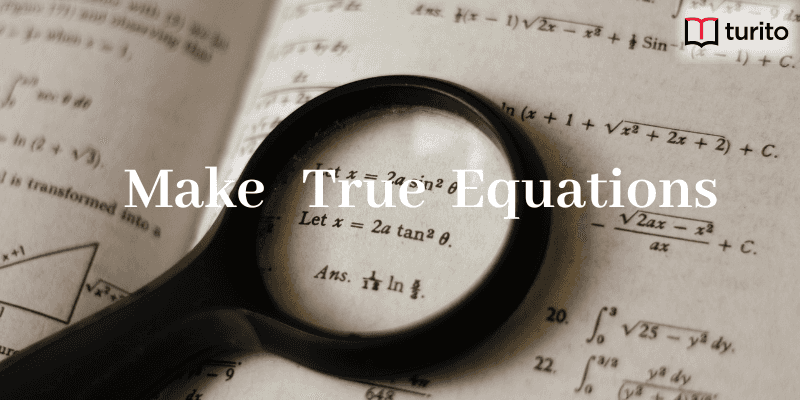Introduction:
1. Pick the equations that are true: –
a. 6 = 12 – 6
b. 7+ 8 = 8 + 7
c. 10 = 10
d. 7 + 3 = 3 + 7
Answers:
a. 6 = 12 – 6, subtract 6 from 12; the answer is 6.
6 = 6, the equation is true.
b. 7 + 8 = 8 + 7; both side equations are true.
c. 10 = 10; both side equations are true.
d. 7 + 3 = 3 + 7; both side equations are true
2. Make the equation true.
- 4 + 6 = _____ + 1
Answer:
Solve one side of the equation first 4 + 6 =10.
to get the other side of the equation, subtract 1 from 10
10 = 9 + 1. The answer is 4 + 6 = 9 + 1
This equation is true.
3. Fill in the missing number to make this equation true: –
14 – ___ = 3 + 3

Solve one side of the equation first.
3 + 3 = 6
You can use counters to find the missing answer.

14 – ___ = 6
Take away 8 counters to get 6; the answer is 14 – 8 =6.
14 – 8 = 3 + 3. This equation is true.
Solve The Following: –
- Observe the box. How many balls do you need to add to make the equation true?
6 + ___ = 10
To get the missing number, subtract the counters ball, i.e.,
6 from 10,
10 – 6 = 4
Answer:
2. Make the equation true: –
15 – ____ = 10 + 2
Answers:
Solve one side of the equation first.
10 + 2 = 12
To get the other side of the equation, subtract 12 from 15.
15 – 12 = 3
So, the missing number is 3.
15 – 3 = 10 + 2
The equation is true
3. Write the missing symbol {+, -, or =} and make the equation true.
17 ___ 9 ___ 4 + 4
Answers: –
To get the answer, observe the equation.
Solve one side of the equation [symbol inserted here] 4 + 4 = 8
Other side values are more than the next side; so, to get lesser values, you need to insert subtraction symbol, 17 – 9.
Subtract 17 – 9 = 8; both the side values are the same, so insert an equal sign in the middle of both equations.
The answer is 17-9=4+4.
4. Alex has a 15-meter-long rope. He made it into two pieces. One piece is 8 m long. What is the length of the other piece?
15 – 8 = ____
Answer:
Use counters and subtract the missing number.
Take away 8 counters from 15; the answer is 7.
15-8=7. The length of another piece is 7 meters.

- Peter has 14 red crayons; his brother gave him 6 more crayons. John has 12 red crayons. His father gave him 8 more crayons. Do they have an equal number of crayons?
Answer:
Peter has 14+6 crayons. When we add, you get the answer 20.
John has 12+8 crayons. When we add, you get the answer 20.
14+6=12+8
Both of them have an equal number of crayons.
Concept Summary


Related topics
Addition and Multiplication Using Counters & Bar-Diagrams
Introduction: We can find the solution to the word problem by solving it. Here, in this topic, we can use 3 methods to find the solution. 1. Add using counters 2. Use factors to get the product 3. Write equations to find the unknown. Addition Equation: 8+8+8 =? Multiplication equation: 3×8=? Example 1: Andrew has […]
Read More >>Dilation: Definitions, Characteristics, and Similarities
Understanding Dilation A dilation is a transformation that produces an image that is of the same shape and different sizes. Dilation that creates a larger image is called enlargement. Describing Dilation Dilation of Scale Factor 2 The following figure undergoes a dilation with a scale factor of 2 giving an image A’ (2, 4), B’ […]
Read More >>How to Write and Interpret Numerical Expressions?
Write numerical expressions What is the Meaning of Numerical Expression? A numerical expression is a combination of numbers and integers using basic operations such as addition, subtraction, multiplication, or division. The word PEMDAS stands for: P → Parentheses E → Exponents M → Multiplication D → Division A → Addition S → Subtraction Some examples […]
Read More >>System of Linear Inequalities and Equations
Introduction: Systems of Linear Inequalities: A system of linear inequalities is a set of two or more linear inequalities in the same variables. The following example illustrates this, y < x + 2…………..Inequality 1 y ≥ 2x − 1…………Inequality 2 Solution of a System of Linear Inequalities: A solution of a system of linear inequalities […]
Read More >>Other topics











Comments: